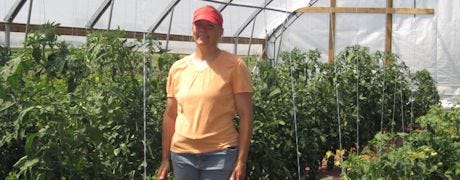
With this spring's wet soils and cool, cloudy weather, many gardeners just recently planted their vegetable gardens, and may be skeptical at the produce already available at farmers' markets. Besides cool season crops like lettuce, green onions, peas and radishes, some farmers may have ripe tomatoes, cucumbers and green beans for sale – but how?

FIRST TO MARKET: High tunnels extend the growing season, allowing them to plant sooner and have produce ready to take to market sooner. "Being the first one to the market with red, ripe tomatoes brings a higher price because everyone is craving garden-fresh tomatoes," says Nicole Jonas, a producer with a high tunnel.
These farmers may be using high tunnels that allow them to plant earlier and have vegetables a few to several weeks sooner than field-grown crops, says Linda Naeve, a value added agriculture specialist with Iowa State University Extension and Outreach. "The high tunnel gives the grower an opportunity to get to market earlier in the season," she says. "As a result they get to command a higher price for their product." she says.
High tunnels extend the growing season
Growers are seeking way to increase production and efficiency while extending the growing season to meet the rising demand of local fruits and vegetables. "People are more conscientious of buying local," Naeve says. "I think they're recognizing that locally produced fruits and vegetables are fresher, taste great, and buying local helps the local economy."
High tunnels – simple, plastic-covered, greenhouse-like structures – are one way to meet this demand, Naeve says. Crops are planted directly in the soil and the environment is typically passively heated and cooled by raising and lowering the sides and opening the ends. The warmer air and soil environment of high tunnels enables Iowa growers to plant cool-season crops in February and March and warm season crops in mid-April, extending the growing season about 6 weeks on either side or more, depending on the crop. "We can plant in a high tunnel as if we were one zone south, or planting in Missouri rather than Iowa."~~~PAGE_BREAK_HERE~~~
It is estimated that nearly 300 high tunnels have been constructed around the state in the past three years. "Some growers are putting up two, three or more on their farm," Naeve says. It is an inexpensive, practical option for small-scale vegetable producers. "It could be about $5 a square foot, where a greenhouse is well over $100 a square foot," she says. "It is a simple structure and doesn't need to have access to electricity."
High tunnel production often results in greater yields of high quality produce, Naeve says. Almost any crop can be grown in a high tunnel; however, because it is a premium growing area, fruit and vegetables that are typically grown in high tunnels include tomatoes, lettuce, peppers, cucumbers and raspberries.
First to market
Nicole Jonas, owner of Red Granite Farm located north of Ames in Boone County, is one such producer with a high tunnel. "After doing a lot of research and attending educational workshops on high tunnel production, we realized it was the way to go to maximize production and profitability," Jonas says. "Being the first one to the market with red, ripe tomatoes brings a higher price because everyone is craving garden-fresh tomatoes."
Jonas also reminds people that most high tunnel tomatoes are grown directly in the soil and have the great, home-grown flavor that people expect from tomatoes sold at the farmers' market. The beauty of the farmers' market is that consumers can talk to the farmers who grew the crops to get the "scoop" on their production methods.
For more information on high tunnels, visit the ISU Value Added Agriculture website. To find a local farm or farmers' market, visit this link.
About the Author(s)
You May Also Like






